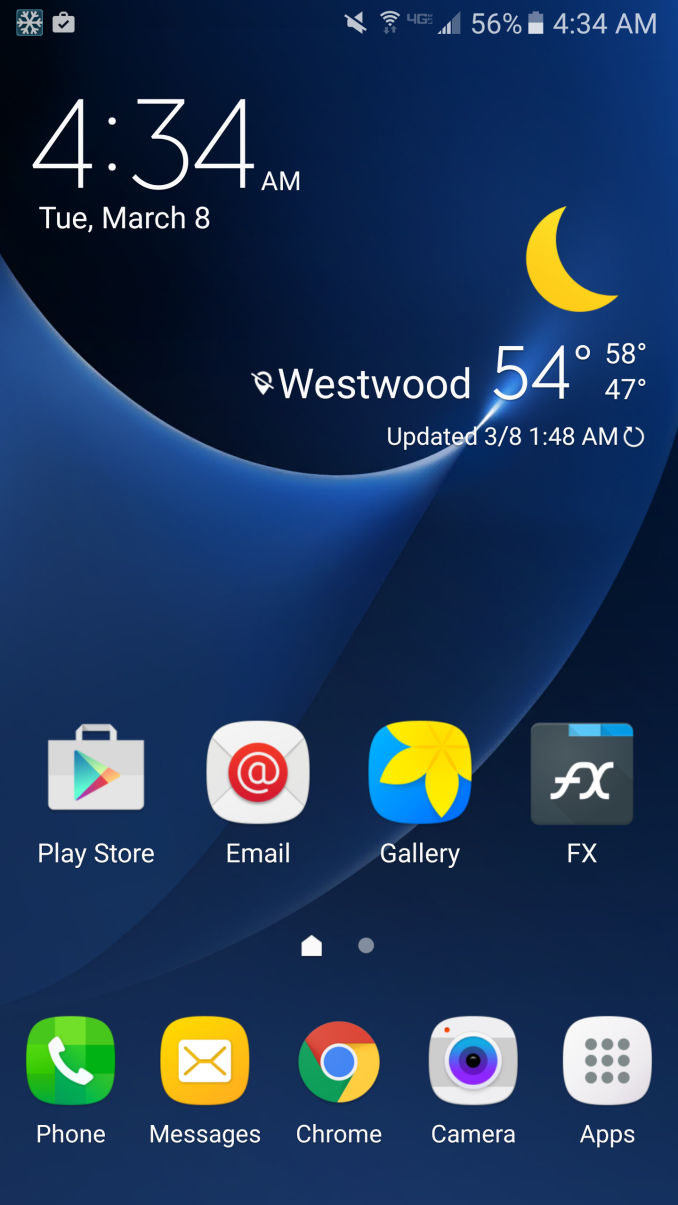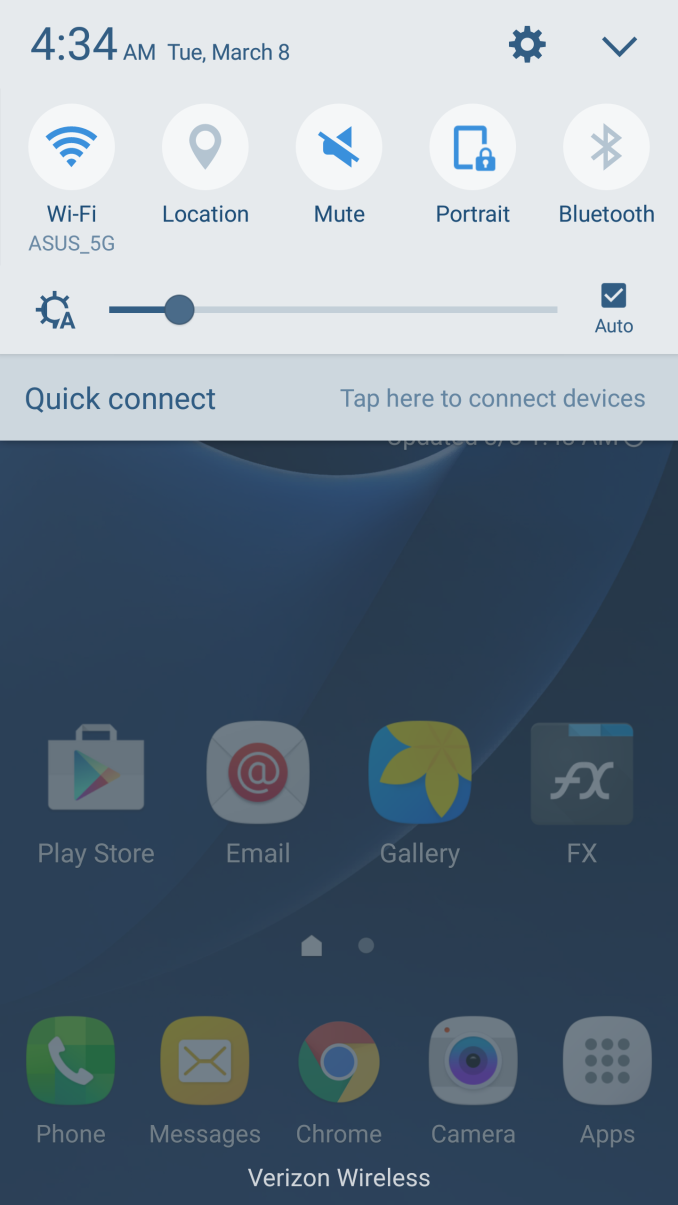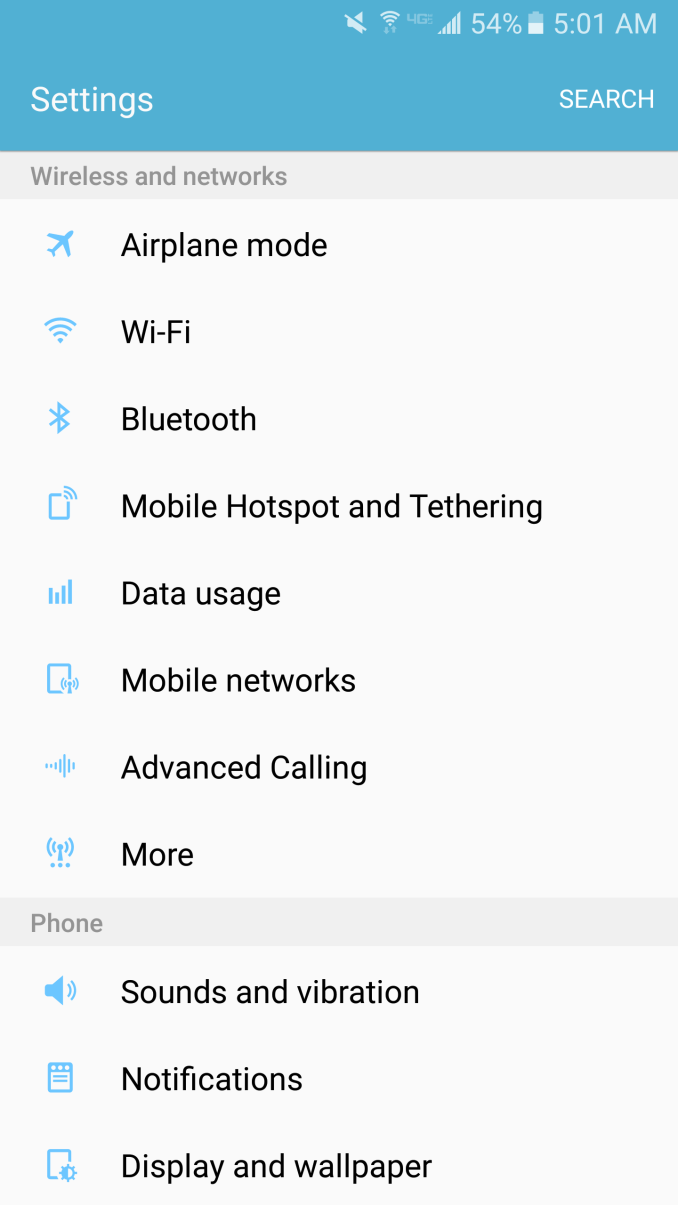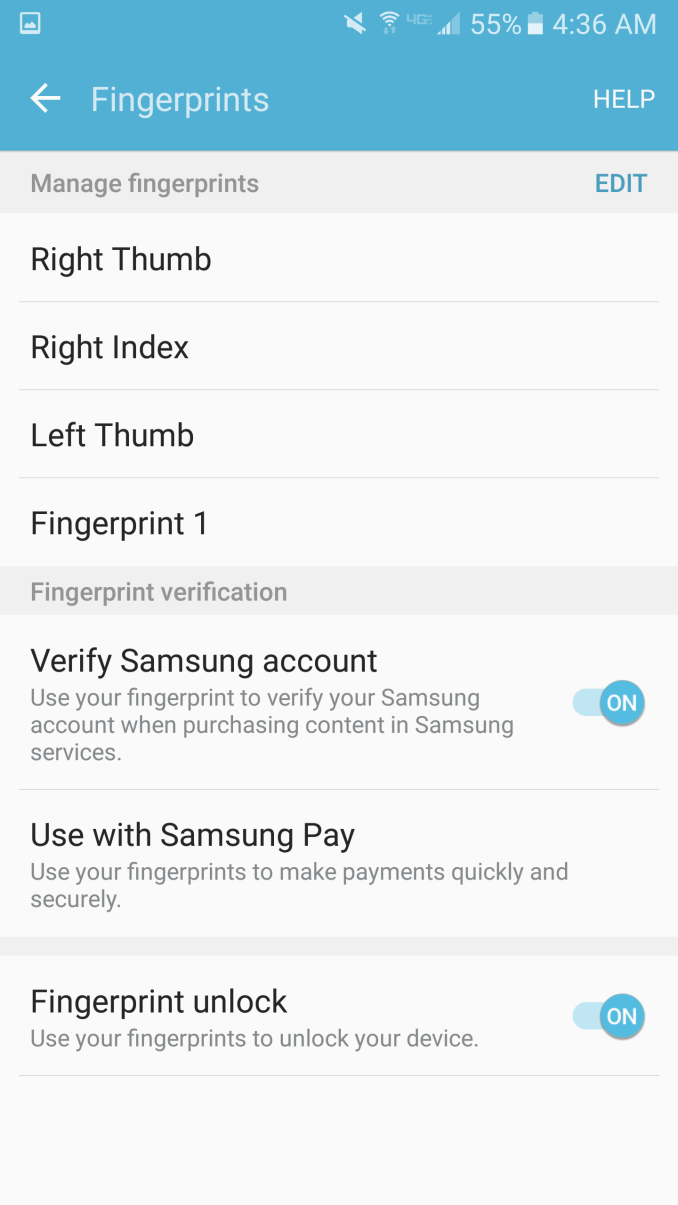The Samsung Galaxy S7 & S7 Edge Review, Part 1
by Joshua Ho on March 8, 2016 9:00 AM ESTSoftware UX
As is always the case, there’s a perpetual debate over the role of the OEM when it comes to Android devices. For better or worse, Samsung seems to believe that they need to add their own framework and UI over Android. To some extent, I suspect that most users are going to find stock Android to be rather spartan out of the box, so it does make sense for OEMs like Samsung to continue adding their own custom applications and frameworks to help differentiate themselves from the competition.
With the Galaxy S5, it was evident that Samsung had dramatically changed their design direction for TouchWiz, but I would argue that their design aesthetic still wasn’t quite perfect, and performance wasn’t completely there either. With the Galaxy S6, Samsung had gotten closer to the mark in some ways, but the continued use of excessively neon colors just made parts of the UI feel off at times, and performance still wasn’t perfect.
With the Galaxy S7, performance has improved noticeably, but it’s really hard for me to say whether this is because Samsung has improved their codebase, or if a faster SoC is just making it harder to notice areas in need of optimization. At any rate, while the Galaxy S7 isn’t perfectly smooth - dropping frames now and then - it is sufficiently performant that you’re not going to find distracting lag.
The default theme of the Galaxy S7 continues to feel pretty similar to the Galaxy S6, so for the most part things are acceptable here, but the use of color is still a bit excessive as a number of icons still use neon colors rather than more neutral pastel colors. Of course, the theme store now has a number of Material Design themes, which greatly improve the situation. I installed one pretty much immediately, which helps make the device feel a lot better in everyday use. However, I’m still of the opinion that this is something that a user shouldn’t need to do out of the box, so this is an area where Samsung can improve.
The other features that Samsung touted for the Galaxy S7 are interesting, but I’m not really sure they’re all that well executed. Always-On Display is nice to have, but for some reason it's quite reluctant to turn off the display when the ambient light sensor and proximity sensor are covered. As a result I turned it off as it’s clearly going to be contributing to idle battery drain in situations where it shouldn’t.
I also found that the fingerprint scanner is pretty much identical to the one in the Galaxy S6, which isn’t entirely surprising as both identify themselves as a Synaptics fingerprint scanner. Both still seem to be quite sensitive to the initial training period and in my experience won’t really work all that well if you don’t cover your entire fingerprint effectively during that period.
Other than this, TouchWiz doesn’t really stand out in any way as of now. Of course, Samsung Pay will be interesting for me to try as I still regularly run into terminals that don’t support NFC in any shape or form, but I haven’t really been able to spend much time testing Samsung Pay yet. I don’t really find TouchWiz to be a bad thing at this point, but I’m not really sure it’s a good thing either. With a serious emphasis on optimization and a major aesthetic overhaul, it’s entirely possible that I could find myself saying quite differently in the near future, but for now if you found the Galaxy S6 and Note 5 OEM UIs to be usable you’ll find the Galaxy S7 to be usable as well.















202 Comments
View All Comments
Belard - Friday, March 11, 2016 - link
What I find shockingly stupid is the release of these new $600~900 phones, including the latest Moto X, that DO NOT include USB-C connector?! Its been available since last year.Apple does things quickly, they come out with technology and release it: such as with the iPhone 5 with its reversible port. How hard is it to do with other companies?
Motorola (Lenovo) could have done this with their New X to make a bold statement on how they are going to run their business.
theduckofdeath - Friday, March 11, 2016 - link
Probably because Samsung has usage data on what we actually use the USB port for these days. And I guess it's used almost exclusively as a charger. Why force the consumers to buy a bunch of new cables and chargers just because there is a new port out there? I know Apple would do that in a heartbeat, like you said, as they simply see it as a new way to increase earnings on licensing accessories.Azurael - Tuesday, March 15, 2016 - link
Because USB-C is much easier and quicker to connect? (I certainly find the 5X and 6P much easier to connect in a darkened room - good thing since Google nicked Qi charging.)Because USB-C cables and sockets should be (probably too early to say, but by design) far less prone to failure than Micro-B? (Micro-B cables, and not cheap ones - OEM LG/Nokia/Sony/Moto cables, die on me on a weekly basis. About half of the cables I own only work for charging now.)
I don't know, why don't we still connect our keyboards with the AT connector or PS/2, and our digital video cameras by firewire?
You don't need new chargers. If you've got dozens of USB-A power supplies, just use an A-C cable.
theduckofdeath - Tuesday, March 15, 2016 - link
I'm not suffering from long connection times when connecting my mobile to the charger. Sure, it would be nice with a more uniform connector, but, if it comes at the expense me having to throw away all old cables, having to bring adapters and generally making life more expensive, I can easily live with a micro USB connector until connectors are entirely a thing of the past.Physical connectors for data transfer is really not essential these days. These phones has wifi and LTE connectivity at speeds close enough to any USB connection to make us not bothering transferring anything by wire any more.
Belard - Tuesday, March 15, 2016 - link
Uh, just need to replace the cable or it comes with the phone... not difficult. A flip-able cable is VERY handy, especially in the dark. Unless the end is marked or molded a different shape - you have to LOOK which side is up. Apple changed the cable ONE time, because they wanted a much smaller and better connector.So for a top end phone, I want a state of the art connector too. hence, I bought a new Moto G for $220... I lose the stereo speakers, but I saved $200 and have two free color covers I switch out for when I'm in the mood. So maybe I'll stick with the Gs.
Bruce Dunn - Friday, March 11, 2016 - link
For the average cell phone buyer, most of the information in this review goes right over their heads. I hope that part 2 of the review will address in simple language the following:Can I read the display in direct sunlight (giving me the number of nits emitted by the display does not tell me this).
What happens if I drop the phone into a sink full of water.
What happens if I drop the phone onto a concrete floor.
peedroo - Saturday, March 12, 2016 - link
http://www.displaymate.com/Galaxy_S7_ShootOut_1.ht...Maximum screen brightness in high ambient light results
s.yu - Thursday, March 17, 2016 - link
Anandtech is not for the "average cell phone buyer". It's for people who *really want to know*. If there were more of us there would be less rip-off products on the market and everything would be easier, more money would be devoted to R&D instead of marketing and more will be achieved.peedroo - Saturday, March 12, 2016 - link
Loved the review till nowBut here
http://www.displaymate.com/Galaxy_S7_ShootOut_1.ht...
...they have tottaly diferent results about screen brightness levels when we compair it to the S6. It's better
karthik.hegde - Sunday, March 13, 2016 - link
I think what article needs to highlight more is that the Kirin 950 handily beats SD820 is most of the tests. ARM Cortex-A72 is a great core, released quite sometime ago still doing pretty well. I am sure ARM has new CPUs in the pipeline which will be released soon.I wonder if it makes sense for Qualcomm from business perspective to continue designing their own cores, while ARM already offers stock cores with great performance.